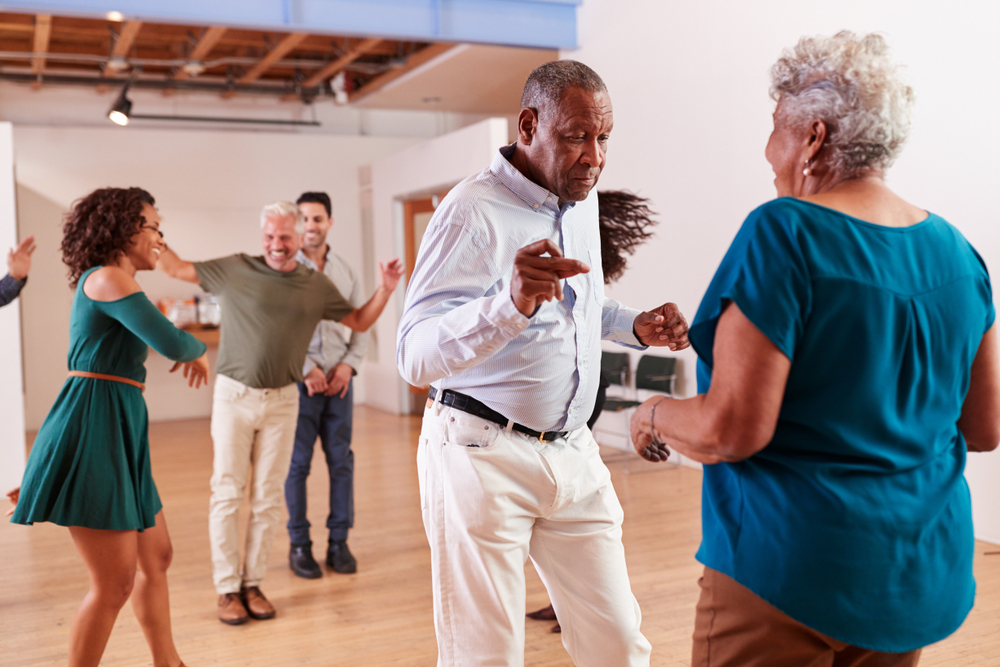Regular exercise is important for everyone but especially for seniors. Reducing your risk of chronic diseases, lowering your chances of injury, and improving your mood, are just a few of the benefits that regular exercise has to offer. Unfortunately, by age 75, one in three men and one in two women engage in no physical activity. The good news is that it’s never too late to start.
According to the Centers for Disease Control and Prevention (CDC), aging adults should get about 150 minutes of moderate-intensity aerobic activity. Cardio is a great form of exercise that offers plenty of health benefits. If you’re ready to take charge of your health today, then give these safe and effective cardio workouts a try. Don’t forget to speak with your doctor before starting a new workout regimen.
Want senior content delivered straight to your inbox? Sign up for our exclusive email list and receive articles and news on diet & nutrition, fitness, and mental health dedicated specifically to our senior audience!
Benefits of Cardio Exercises for Seniors
There are many great forms of exercise for seniors from yoga to strength building and beyond. Cardio specifically, can benefit seniors as it can strengthen your heart and lungs.
It will also provide you with more energy, help you manage your weight, and may even keep your brain young! Others also find that cardio helps relieve stress and helps to ward off symptoms of anxiety and depression. As you can see, there are so many great reasons to start enjoying cardio today!
How Much Cardio Do Seniors Need?
Now that you know the benefits of cardio you might be wondering how much cardio do you actually need? As discussed previously, the CDC states that aging adults require about 150 minutes of moderate-intensity cardio. This can also be broken up into 30-minute workouts, five days a week.
Alternatively, you could also engage in vigorous cardio for 20 minutes about three days a week. Or you may enjoy a mix of both moderate and vigorous cardio from three to five days a week. Find what feels best for you and work your way up to more intense workouts once you gain strength and endurance.
Cardio Safety Tips for Seniors
While cardio is safe for most seniors, there are some tips you should know that will ensure you make the most of your workout while doing so safely. For starters, it might be best to speak with a physician to determine what are realistic exercise goals for you. Second, it’s important to choose the right exercise footwear. Wearing the proper shoes can help prevent injury while performing your exercises.
Furthermore, while exercising, make sure you always stay hydrated because this will help keep you energized throughout your workout. Finally, don’t forget to warm up and cool down after exercising as this will help prevent injuries.
Walking
Walking is an excellent form of cardio exercise and will get your heart rate up! Before walking be mindful of your walking route. It might be best to ensure it’s a familiar route and free of debris and obstacles all of which will help prevent falling.
Other tips for a better walking workout include swinging your arms naturally and shortening your stride while focusing on coordination like rolling the foot from heel to toe. This is important for improving balance so you can eventually accelerate your walking speed. Further, it’s important to keep your head up while walking. Keep your eyesight straight ahead, not down and not up as this will ensure proper head alignment and prevent injury.
Jogging
If you enjoy walking but are ready to step it up a notch then jogging is the next step for you! Studies also show that those who run for at least 30-minutes, three times a week were less likely to experience age-related physical decline.
Before jogging, it would be a good idea to start with a warm-up of a brisk walk for about 5-minutes. Then start running at a moderate pace for about 2 to 3-minutes. Recover with a brisk walk for another 2 to 3-minutes before repeating. Repeat this pattern for up to 35 minutes and finish with a cool down such as a 5-minute walk.
Cycling
Cycling is another great form of cardio exercise for seniors. Cycling also places little pressure on your joints and requires your body to move in smooth motions making this a great low-impact exercise.
If the weather is nice then you may enjoy cycling outdoors where you can enjoy the scenery and fresh air. You can also cycle on an exercise bike at a gym or in your home.
HIIT
Have you heard of HIIT? Also known as high-intensity interval training. This type of workout uses bursts of intense effort movements with short rest periods. While this may seem intimidating for some, know there are many variations suitable for seniors.
Some of the benefits of HIIT workouts include improves muscle development, memory, and cardiovascular health. If you want to give it a try check out this beginner HIIT workout. Our senior fitness expert, Meredith Chen, shares instructions for a full-body HIIT workout with a video included so you can follow along.
Swimming
Swimming is a great cardio exercise that is low impact which means it won’t put stress on your joints. Not only will a swimming workout increase your heart rate without putting stress on your body but it will also help you build strength and tone muscles.
To get started find a local pool near you. You can try working out in the pool on your own or you can join an aquatics fitness class to help get you started.
Dancing
If you enjoy dancing, you’ll be happy to learn that it too can be a great cardio workout! There are many benefits of dancing from reducing symptoms of depression and anxiety to improving balance and heart function and more!
There are so many ways you can get started. You can follow along with a workout video at home, join a dancing class, or you can check out this low-impact salsa dance workout. Our senior fitness expert, Meredith Chen, is sharing a salsa dance workout with a video so you can follow along!
Gardening
Did you know that gardening can be considered a cardio exercise? All that digging, raking, and planting is going to get your heart rate up and your muscles working. In fact, gardening for just 30-40 minutes can burn up to 200-300 calories!
If you want to make gardening a structured exercise routine, then consider alternating light activities with heavier ones. For example, you may want to start by raking the yard followed by digging a few holes for plants and then prune a shrub. Just like with any other workout, make sure you start with a warm-up and finish with a cool down to help prevent injury.













